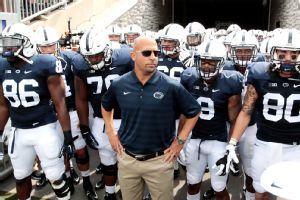 |
| Photo by Matthew O'Haren (USA TODAY Sports) |
Yesterday, I still wasn't sure how to feel about the reinstatement. I was open to it, but I felt that the timing was absolutely terrible. Then, I saw a Dan Wetzel tweet last night.
At Penn St, celebration for end of Sandusky sanctions turns to restoring Paterno Statue https://t.co/ckI0PGlZii (via @OnwardState)
— Dan Wetzel (@DanWetzel) September 9, 2014
Let me be clear. I have no problem with the fact that students, alums, and other fans assembled to celebrate. That's their right. I might have done the same in their situation. It's a good thing to get your team back to full strength. But the lengths they went to are disturbing. These people are demanding the reinstatement of a statue of someone who admitted they didn't do enough.There are a few common arguments that Penn State fans and others have been using against the sanctions. "The NCAA doesn't have jurisdiction over what happened." "The people responsible for what happened are no longer at Penn State." "You're punishing innocent kids." "This has nothing to do with the football program." On and on it goes. In 2012, I addressed a few of these concerns. I think they still hold true today.
Obviously, I don't know the exact details of what happened in State College between 1998 and 2011, when the subhuman Jerry Sandusky was finally arrested for his crimes. But based on the Freeh Report (which yes, I know, has some question marks to it based on the reputation of Louis Freeh), unless the emails they found are fake, the following facts can be established.
- In May of 1998, there was a police report filed regarding Sandusky showering with one of the victims. An investigation takes place, but police decide there's not enough evidence to charge him. By early June, the investigation is closed.
- During this time, PSU officials (including Joe Paterno, according to emails), are kept up to date with the proceedings. They know there's an investigation here.
- In 1999, Sandusky retires as an assistant coach of the football team. Despite the lack of precedent for such a move, on August 31 of that year, Sandusky was granted emeritus rank, which allowed him continued access to "recreational facilities" on campus.
- In 2000, then again in 2001, janitors and Mike McQueary, respectively, saw alleged sexual misconduct in the football building. While the janitors never reported what they witnessed, McQueary told his father about it, and then went to tell Joe Paterno.
- Joe Paterno told a grand jury in 2011 that McQueary told him something sexual in nature happened in the building. Paterno reported it to his superiors, and they met more than once to follow up on the allegations. Despite this, no police report is filed.
I don't know what the rationale was in 2001 for not doing more. But based on the facts above, I remain convinced that Paterno, Spanier, Schultz and Curley are all at the very least morally guilty for not doing more to dig into this. Had a police investigation been opened and nothing been found, these men would not be facing the scrutiny they are. Instead it would fall on the police, based on wondering how they could have found nothing not once, but twice.
So back to 2014. For people to think Paterno was innocent (I'm looking at the attorney general as well, despite the claim that Paterno probably wouldn't have faced charges had he not passed away in early 2012) is naive at best. Unquestionably, he did a lot of good for a lot of people. But we can't forget about the people he failed.
These fans need to realize that it''s okay to celebrate the release of sanctions. They just need to remember why the sanctions were imposed in the first place. Problem is, they aren't. This is why the sanctions were necessary in the first place. People claim there isn't a culture problem at Penn State, but there clearly is. People want not only the statue, but Paterno's official win total to be brought back to its on the field total of 409. Paterno's legacy is more important to some people than what happened in the football facility 15 years ago. That's why I tweeted this last night after seeing Wetzel's tweet.
The more I see, the more I think Penn State should have gotten the death penalty. They don't get it.
— Lucas Mitzel (@northsider89) September 9, 2014
Priorities, people. You can be happy that sanctions got reduced. Just remember what put you in a position to celebrate their removal in the first place. 
No comments:
Post a Comment